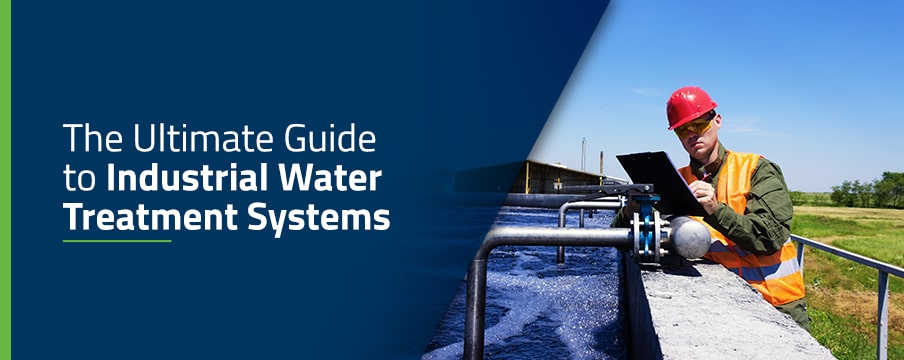
A cooling water system absorbs heat from one area and rejects it to another area. There are many different configurations and designs, but all cooling water systems accomplish the same objective — moving heat. Billions of gallons of water are used daily in commercial and industrial applications to accomplish this objective. Industrial uses of water include air conditioning and heating systems, furnace cooling systems, plastic mold heating and cooling systems, and refrigeration, compressor and welding machine cooling systems. Regardless of the application, all cooling systems have one objective — absorb heat from one area and reject it into another area.
Heat always follows the second law of thermodynamics, which is matter and energy flow from a higher concentration to a lower concentration. When water encounters a hot surface, heat flows from the hot surface to the water. When the water encounters a cooler surface, it transfers the heat to the cooler surface.
To ensure adequate heat transfer, regardless of the cooling water system used, the water needs to be clean. Process water, boiler and cooling tower water treatment create the chemical balance to preventing fouling of the system and inefficient operation. For any facility with a steam boiler, cooling tower or industrial process water, water treatment can extend the lives of the infrastructure of these systems, reducing maintenance and repairs while ensuring efficiency.
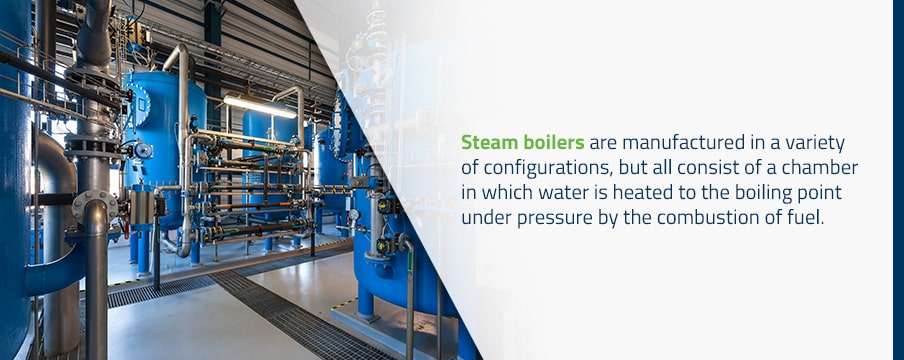
Steam boilers can be considered a special type of closed loop wherein water is heated to the boiling point. Steam boilers are manufactured in a variety of configurations, but all consist of a chamber in which water is heated to the boiling point under pressure by the combustion of fuel. Steam is delivered to heat exchangers or air handler coils where the heat flows to the material being heated. As heat is lost during this process, the steam condenses back to water and is pumped back to the boiler.
The water for this process must be purified, avoid foaming, and have the correct pH chemistry to prevent scaling. To achieve these qualities, the makeup water needs processing through filtration and chemical balancing before proceeding to the boiler. These steps depend on the boiler manufacturer’s recommendations and the chemistry of the makeup water. Some of the steps may include filtration, purification through reverse osmosis, chemical addition, and mixing and distribution.
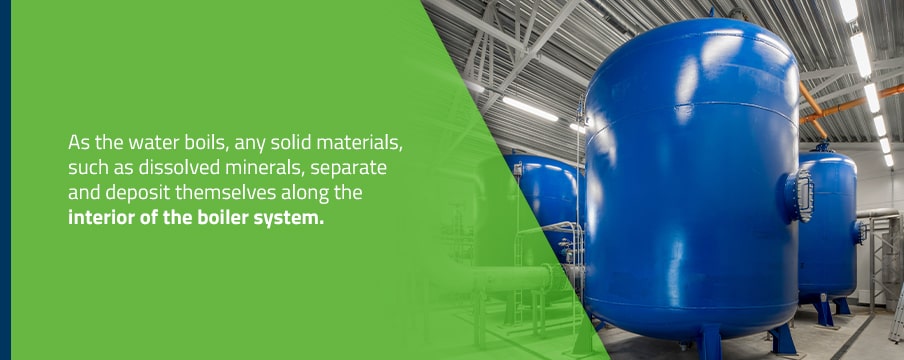
Heating water to a boil creates special problems for the feedwater system. As the water boils, any solid materials, such as dissolved minerals, separate and deposit themselves along the interior of the boiler system. Excessive buildup slows the flow of water through the boiler, reducing its heat exchange capabilities. Therefore, boiler feedwater treatment for a plant is essential for keeping the system working well.
While scale from minerals is important to avoid, so is the costly consequence of corrosion of boiler piping for any facility that uses boiler and cooling tower water treatment.
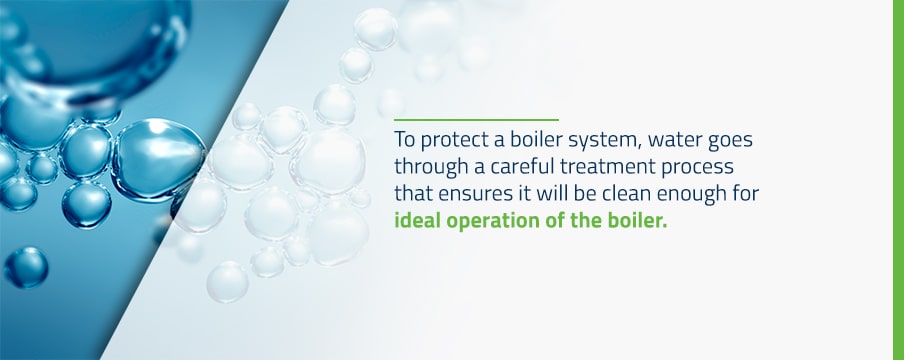
To protect a boiler system, water goes through a careful treatment process that ensures it will be clean enough for ideal operation of the boiler. This process includes several steps to chemically mitigate the negative effects of contaminants in the water and protect the longevity of the boiler. Plus, the treatment system saves money by reducing the energy costs needed to heat water in the boiler.
The boiler feedwater treatment process starts with testing the water to see the type of chemicals it needs. This testing process serves as the first of many used to monitor the water quality and the need for future alterations in the amounts of chemicals used.
Next, the ISO-certified technicians choose chemicals to balance out the imperfections in the water, prevent scale and protect against corrosion. They also schedule regular maintenance of the boiler and a testing schedule to ensure proper water balance.
To create a water treatment system, technicians install probes, and other testing devices connect from the boiler to control systems, allowing the system to automatically turn on chemical pumps to feed more treatment chemicals into the water as needed. The chemicals and equipment used for water treatment work together to make the process of maintaining chemically balanced water that prevents corrosion and scaling easier.
Boilers use several pieces of equipment to ensure proper monitoring and dispensing of water treatment chemicals. These vital additions to the system include the following:
These pieces of equipment work in conjunction with each other to ensure the system’s water stays in a balance between testing and maintenance periods.
The chemicals used in boiler feedwater provide protection against several damaging effects, such as foaming, corrosion and scale. Specific chemicals used to control these effects depend on the water. The categories of chemicals used to treat boiler water include:
When balanced and added to the boiler feedwater in the correct amounts, the above chemicals can prevent scale, reduce boiler heating costs and extend the life of the equipment.
Steam boilers that are not properly treated can cost you thousands in fuel and energy. Check out more information about what Chardon can offer for your boiler!
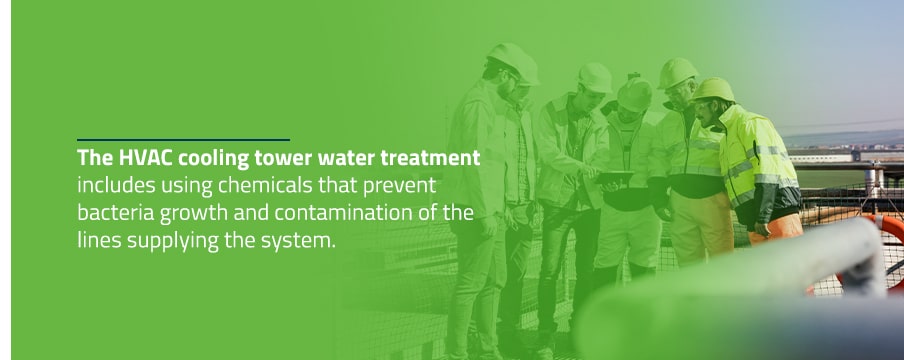
The HVAC cooling tower water treatment includes using chemicals that prevent bacteria growth and contamination of the lines supplying the system. Since the open-air cooling towers allow for external contamination of the system’s water while in use, chemical balancing to prevent microbe growth, scale, corrosion and rust is essential.
Cooling towers can vary in size from several square feet to several hundred square feet, but all cooling towers have the same basic function— to increase the surface area of the air/water interface by breaking the water into droplets or thin films. This results in more efficient evaporation of water and therefore rejection of heat from the system. Several different tower shapes and interior designs have been developed to accomplish this.
The induced-draft tower has one or more fans located in the air outlet from the tower, and air is pulled into the tower by fans located on top of the tower. The forced-draft tower (figure 9 and 10) has one or more fans located in the air intake to the tower, and air is pushed into the tower by fans located on the side of the tower.
Cooling water containing excess heat is pumped to the top of the cooling tower where it flows into a distribution pan. The bottom of the distribution pan has many small diameter holes. Water flows out of the pan through the holes into the interior of the tower, which features a complex of packing or slats referred to as fill. The fill increases the amount of water exposed to air by providing a large surface area for the water to traverse. Air from the fan is moved across the water to cause increased evaporation, resulting in greater efficiency in removing heat from the water and rejecting it to the atmosphere.
Another method for increasing the surface area of the water involves the spray method wherein the water is pumped into spray nozzles located inside the tower, which discharge water in the form of small droplets. Air is blown across the droplets, which increases evaporation and heat rejection to the atmosphere. One common application of the spray methods is the fluid cooler. In this design, process fluid containing heat is circulated through a series of tubes suspended inside the cooling tower. Cooling tower water is sprayed over the tubes, where the heat is absorbed by the cooling water and rejected to the atmosphere by the evaporation process.
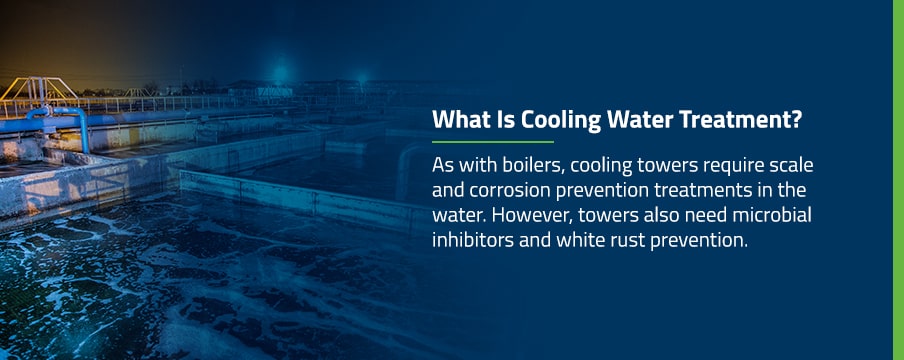
One of the major concerns of cooling towers is the method they use to eliminate heat from the system. By being open to the environment, they present a prime spot for system contamination. Therefore, treating the water chemically in these towers is essential to preventing serious consequences.
As with boilers, cooling towers require scale and corrosion prevention treatments in the water. However, towers also need microbial inhibitors and white rust prevention. The specific chemicals used for treating water in a cooling tower depend on the amount of makeup water required and the existing purity and chemistry of that water.
The process of treating water for a cooling tower system includes both monitoring and maintaining chemistry of the makeup, sidestream and blowdown water sources. As with boilers, makeup water must go through filtration and purification before the addition of chemicals to soften the water, prevent microbe growth and reduce scale buildup. Filtering and treating sidestream and blowdown water can keep the system pristine by removing anything brought into the system through typical use, such as contaminants drifting into the water in the tower.
Equipment and chemicals used for creating the proper cooling tower water treatment reduce the effort required for facility managers while ensuring the tower effectively and efficiently cools the facility with as little contamination as possible.
For cooling tower water treatment systems to work continuously, they require the addition of equipment to monitor the composition of the water and regulate the addition of fresh water and chemicals. The equipment needed may include the following parts:
These pieces of equipment each play a role in measuring cooling tower water quality and delivering the appropriate chemicals and biocides needed for the system. For installation of the equipment and determination of the types of chemicals used, professional technicians need to evaluate the system to plan for the best balance of chemicals and the methods of delivering them.
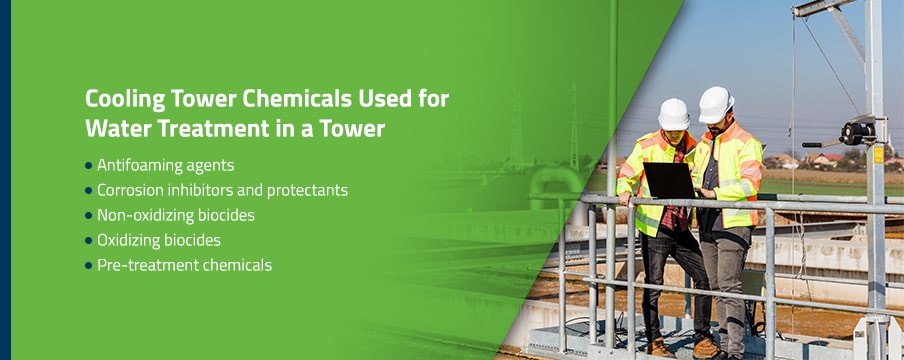
The chemicals added to water for a cooling tower act as the heart of the treatment system. There are a variety of chemicals used based on the existing state of the water. For instance, non-oxidizing biocides act as antibioticswhile correcting water issues such as pH problems or improving water quality. Each system requires a tailored group of chemicals to compensate for specific water quality concerns. Some chemicals used for cooling tower water treatment include:
The chemicals added to cooling towers have several functions, all of which can reduce long-term operating costs and protect the cooling tower from premature damage. For instance, pH regulating chemicals used as pre-treatment can raise the pH of acidic water that could lead to corrosion or lower the pH of alkaline water that could produce scale buildup.
Biocides kill bacteria, algae and other things that could grow in the water and contaminate it. The selection of appropriate biocides depends on the regulations for discharge water, quality of the makeup water and other factors. Not all cooling towers will use the same oxidizing biocides. Some may require more specific treatments with non-oxidizing agents to kill bacteria.
In some cases, the addition of an excess of biocides causes foaming in the water. When the water in a cooling tower foams, it loses some of its heat-releasing ability, reducing the system’s efficiency. Antifoaming agents combat this problem, allowing the system to continue to use biocides without a reduction in operational capability.
As with boilers and other systems that use treated water, scale and corrosion prevention are paramount to the longevity of the equipment. Unchecked corrosion leads to pinhole leaks that can worsen, causing higher water use costs and a loss of system efficiency. Scale buildup slows the pace of water through the system and can compromise its ability to successfully move heat out of the building. Treating the water to prevent both scale and corrosion ensures the system lasts longer while continuing to operate at a peak performance level.
Only trained professionals should use the data from water quality monitoring to choose the correct chemicals to use. The selection of chemicals for treating cooling tower water is important, as is the amount of the chemicals used. Because the system may change during the seasons or with the amount of usage of the HVAC system, the amounts of chemicals used to treat the water may change, too. Therefore, regular checkups for maintaining the quality of the water and the treatment system ensure the water remains properly balanced throughout the year.
Cooling towers are a part of complex water systems that can quickly foul up and cause building-wide issues and even shutdowns. Find out more about how Chardon can meet your cooling tower service needs!
Industrial water treatment systems have various methods of operation. For instance, closed loop, once-through and recirculating systems are varieties used for transferring heat for industrial processes. Additionally, industrial water cleaning may include treating water for steam boilers or cooling towers. Regardless of the type of system used, treating the water can protect the pipes, ensure efficiency, prevent leaks and keep the system running well.
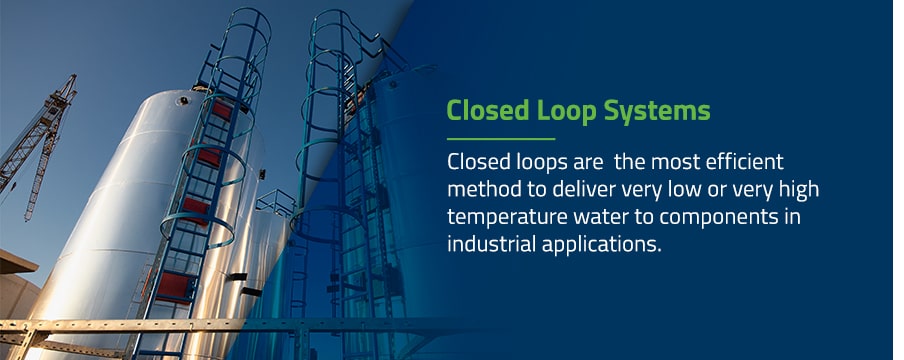
Closed recirculating systems including chilled water loops and hot water boilers are commonly used to deliver hot or cold water to air handlers for heating and air conditioning or to industrial devices which require heating or cooling. Closed loops are an integral part of most comfort cooling systems and are responsible for delivering the heat or cooling to the air handlers which make the building comfortable for its inhabitants.
Closed loops are also the most efficient method to deliver very low or very high temperature water to components in industrial applications. Most closed loops consist entirely of pumps, pipes and heat exchangers, although some systems involve open sumps to allow larger volumes of water.
Closed loop systems require proper water treatment to protect the closed system. Any impurities in the water will magnify with continued use of the water in the system. Therefore, the treatment process starts with an industrial purified water system before adding chemicals to the water to correct specific issues.
Despite their closed nature, closed loop systems require more attention than some may assume. For instance, a closed loop system can lose no more than 10% of its water volume each year. Therefore, over time, even losses of 5% can add up. The water loss will require the addition of makeup water to the system and a rebalancing of the chemistry of the water.
Maintaining water chemistry in a closed loop system may include changing water filters, monitoring water quality with probes, using corrosion coupons and flushing the system regularly. Controlling the chemistry of the water reduces corrosion and scale in the system. Corrosion and scale can lead to leaks that require costly repairs or more frequent maintenance.
Due to the variety of closed loop systems that include hot and cold water circulation, the type of chemicals used will also differ. Closed loop chemicals include additives to treat hot water systems and products specifically for use in cold water loops.
Some closed loop system water treatment chemicals a system may use include antifoaming chemicals and inhibitors. An antifoaming agent prevents the foam formation inside the closed loop system that lessens its ability to move heat. CTA-800 is one such chemical used for closed loop systems.
Inhibitors include a variety of chemicals to reduce pitting and other forms of corrosion inside closed loop systems. The types of agents used depend on the conductivity of the equipment, the pH of the water and whether the system is a hot or cold closed loop system.
For instance, SN7 works in cold closed loop systems. It scavenges oxygen that causes pitting and it produces a protective layer inside the system, preventing corrosion on yellow metal alloys such as brass and copper.
Another inhibitor is SN-88, which technicians use in systems with low conductivity. SN-10 protects hot water closed loop systems by creating a protective layer on ferrous metals. For chilled loop systems that have aluminum components, Charlumina uses azole and sulfite to protect against corrosion.
The water in closed loop systems should be regularly treated to ensure the heat exchange process is efficient and cost-effective. Check out more about what Chardon can offer for your closed loop system!
In a once-through system, water circulates through the system to absorb heat only once and is then passed to the drain. As water and sewage costs increase and environmental controls on discharge into streams, ponds, rivers and lakes are tightened, many once-through systems are being replaced by recirculating systems.
These systems can occur in many different configurations, but the primary purpose of absorbing heat from one area and rejecting it into another remains the same. The hypothetical simple recirculating system involves water pumped from a holding tank or sump through the equipment or machinery to be heated or cooled. The water absorbs heat from the equipment and carries it back to the sump where heat is rejected into the atmosphere by natural evaporation.
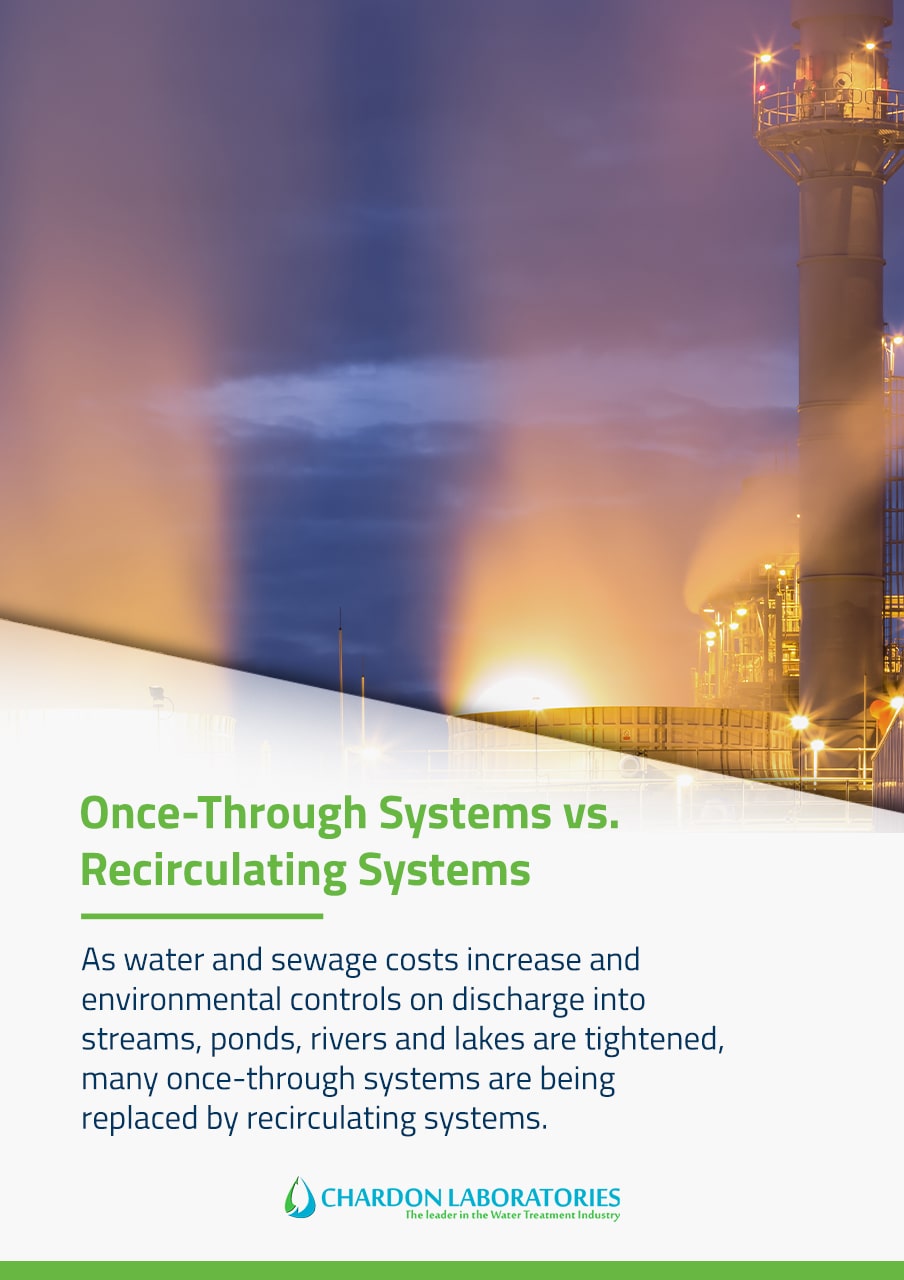
Water treatment in a factory includes preparing the water for use in a variety of processes, including for use in once-through or recirculating systems. Often, the water treatment will include purification before having specific chemicals based on its use. Depending on the layout of the facility, some industrial operations may fully treat all raw water before distributing it to the various systems such as steam boilers, cooling towers or process water systems or have individual filters as the final treatment step at each of the process water systems.
Typically, technicians choose chemicals for each process based on the design of the system and its water usage needs. Therefore, the chemical tanks and pumps are near the systems they treat. For instance, cooling water towers may need biocides that closed loop systems don’t need. Using separate treatments for each system instead of treating all process water first ensures appropriate balance for the water based on its application.
Raw water may have origins from recirculated process water, nearby lakes, rainwater or groundwater. This water has yet to go through standard processing to make it acceptable for human consumption or industrial use. Facilities that use raw water must have filtration systems on-site to prepare the water for its intended purpose.
The first steps for raw water treatment include large sediment filtration and killing bacteria in it. Disinfecting the water may require antimicrobial chemicals or using heat or sunlight. Some water may require softening to chemically offset the dissolved solids in it. Filtration of fine particles is the last stage before using the water for processes around the facility.
Wastewater treatment is another type of industrial water filtration that facilities may perform. The level of filtration and treatment of the wastewater depends on whether the water will recirculate for reuse as process water or if it leaves the facility into nearby rivers or lakes. Some areas require reducing the amounts of chemicals or toxins in wastewater before allowing it to enter the environment. These requirements also play a role in the type of treatment wastewater needs.
In many cases, the type of wastewater treatment closely mirrors that of raw water treatment, especially for instances when the facility may recycle the wastewater for reuse. For facilities that return wastewater to the environment, removing chemicals or products from the water that could damage nearby water systems is important for maintaining the health of nearby ecosystems and adhering to local laws.
Find out more about the many water treatment chemicals and services that Chardon Labs provides for industrial water treatment. We install the equipment, provide remote monitoring, remove containers of chemicals when we leave and only send ISO-certified tech to sites. With proper water treatment, our customers save money by having systems that operate better and need less maintenance. Contact us at Chardon Labs for full-service water treatment that ensures systems stay clean.